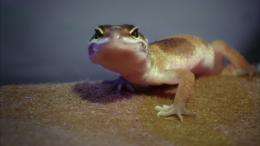Slow-motion film reveals what happens when lizards drop their tails

Timothy Higham, an assistant professor of biology at the University of California, Riverside, will be featured in the program “Animal Superpowers: Extreme Survivors” on the National Geographic Wild Channel, 8 p.m., ET and PT, Sunday, June 3.
Broadcast internationally, the series Animal Superpowers is hosted by the actor Sir Patrick Stewart. On the Extreme Survivors episode, Higham will discuss what happens when a lizard ‘drops’ its tail — an escape plan unique in nature that lizards use when they are attacked. Using high-speed cameras, Higham reveals precisely how the tail fools predators, allowing the lizard to escape and survive. The research may, in the future, help humans with spinal cord injuries.
“Lizards are incredible in their ability to self-amputate their tail when they encounter a predator,” Higham said. “The tail, containing a portion of the spinal cord, is voluntarily detached by muscular contractions that break the tail at a weak point within a single vertebra. The tail contains many of these weak points, so the lizard can break off variable amounts of the tail.”
Higham explained that the tail, once dropped by the lizard, continues to move around vigorously, doing flips and swinging back and forth. This movement distracts the predator while the lizard is able to run away and avoid being eaten.

“Incredibly, the tail is able to move around for up to 30 minutes, without a brain and without any blood flow in or out,” he said. “The fact that this detached portion of spinal cord can move around in different ways indicates that complex motor patterns are responsible and the tail can somehow ‘decide’ when to change its behavior. This provides a great system for studying spinal cord injury given that these lizards are voluntarily severing their spinal cord and then ultimately re-growing it! There are lots of aspects of tail autonomy that remain a mystery, but future work will help reveal these secrets.”
Higham’s lab focuses on biomechanics, functional morphology, and comparative physiology of vertebrate locomotion and feeding. He received his doctoral degree in molecular, cellular and integrative physiology from UC Davis in 2006. Following a postdoctoral appointment at Harvard, he spent three years as an assistant professor of biological sciences at Clemson University. He joined UC Riverside last year.
Viewers are encouraged to check their local listings for “Animal Superpowers: Extreme Survivors” on the National Geographic Wild Channel.
More information: animals.nationalgeographic.com … imals/schedule/wild/
Provided by University of California - Riverside

















